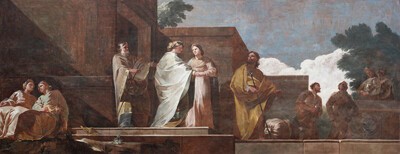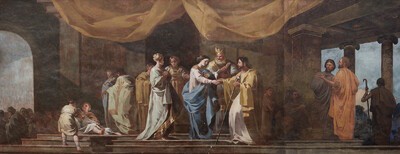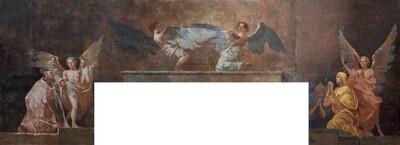- Cronología
- Ca. 1774
- Ubicación
- Church of the Monastery of Aula Dei, Zaragoza, Spain
- Dimensiones
- 306 x 1.025 cm
- Técnica y soporte
- Oil on plaster
- Reconocimiento de la autoría de Goya
- Documented work
- Titular
- Instituto Chemin Neuf
- Ficha: realización/revisión
- 07 Oct 2010 / 13 Jun 2023
Along with Epiphany (La epifanía), this is one of the largest paintings in this set, measuring more than 10 metres. The painting spans the three walls of the transept where it is situated, these being united by obtuse angles to form a triptych.
The same compositional pattern is repeated once more, with a main group situated in the centre of the scene, illuminated and emphasised by bright, vivid colours. The scene is completed by two more secondary groups of figures situated to each side, at times almost in the shadows. The whole scene takes place outdoors, in an open landscape featuring some secondary architectural elements, with trees, blue skies and clouds forming the main part of the background.
The central scene represents the Hebrew rite of circumcising newborn boys, presided over by a priest with a white beard reminiscent of the figure who appears in the The Marriage (Los desposorios). Similarly, the representation of Mary with her beautiful face has features and clothing echoes that of the Visitation (La Visitación). The light that illuminates the group seems to emanate from the figure of the Christ Child, depicted naked and lying on the altar stone before the hands of the priest. The Virgin watches the scene with a natural expression of concern, while the woman sat behind the priest in the middle ground also expresses a mixture of worry and distress. Saint Joseph is once again shown in the middle ground with the flowering staff and a cloak in bright ochre. The group is completed by a woman with her back to the viewer wearing a cloak and veil who helps the priest with the ceremony, and a man in similar dress placed behind her. In the centre there is a large flagon that centres the group.
On the left, two angels on clouds hold up a great medallion bearing the monogram of the name of Jesus: IHS. Above them, a small angel unfolds a canvas as if he had uncovered the medallion for the viewer to see.
On the right-hand side there is an imposing female figure that stands out against an architectural background which opens into a semi-circular arch: her right hand holds the tunic which covers her head and body, while her left hand points gracefully to the space under the arch, as if inviting the figures crouched on the ground in front of her to pass through it. She is accompanied by various lightly sketched figures. In the centre of this section of the work there has clearly been some repainting over the original.
See Revelation to Saint Joachim and Saint Anne for a history of the complete set of works housed in this church.
Restauradas por Carlos Barboza y Teresa Grasa entre 1978 y 1979.
Restaurada por el Gobierno de Aragón entre 2009 y 2011: se hizo un estudio del estado de conservación, limpieza, consolidación, eliminación de sales, análisis y estudios ambientales, eliminación de elementos nocivos para la película pictórica, saneamiento y restauración de grietas, restauración de marcos y dotación de una iluminación apropiada.
-
Goya, su tiempo, su vida, sus obrasMadridTipografía de Manuel G. Hernández, Impresor de la Real Casa1887p. 462
-
Vie et ouvre de Francisco de GoyaParísOffice du livre1970pp. 39-41 (il.), cat. 42-48
-
BarcelonaPolígrafa1970vol. I, pp. 241-242
-
Las pinturas de Goya en la Cartuja de Nuestra Señora de Aula-DeiZaragozaMutua de Accidentes de Zaragoza1975
-
Sobre los documentos conservados en la cartuja de Aula DeiSeminario de Arte AragonésZaragoza1980pp. 119-122
-
Goya y Aragón. Familia, amistades y encargos artísticoscol. Col. Mariano de Pano y RuataZaragozaCaja de Ahorros de la Inmaculada de Aragón1995pp. 107-118 (il.)
-
Las pinturas murales de Goya en AragónMadridGobierno de Aragón y Electa España1996pp. 39-47
-
Las pinturas murales de Goya en la cartuja de Aula DeiFundación Goya en Aragón y Turner2008vol. II, pp.123-137
-
Goya antes del viaje a Madrid (1746-1774)BarcelonaGalaxia Gutenberg/Círculo de Lectores y Fundación Amigos del Museo del Prado2010pp. 315-336






